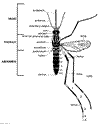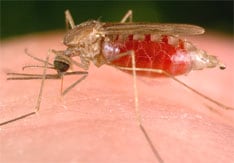A chemical that rid mice of malaria-causing parasites after a single oral dose may eventually become a new malaria drug if further tests in animals and people uphold the promise of early findings. The compound, NITD609, was developed by an international team of researchers including Elizabeth A. Winzeler, Ph.D., a grantee of the National Institute of Allergy and Infectious Diseases (NIAID), part of the National Institutes of Health.
“Although significant progress has been made in controlling malaria, the disease still kills nearly 1 million people every year, mostly infants and young children,” says NIAID Director Anthony S. Fauci, M.D. “It has been more than a decade since the last new class of antimalarials — artemisinins — began to be widely used throughout the world. The rise of drug-resistant malaria parasites further underscores the need for novel malaria therapies.”
Dr. Fauci adds, “The compound developed and tested by Dr. Winzeler and her colleagues appears to target a parasite protein not attacked by any existing malaria drug, and has several other desirable features. This research is also a notable example of successful collaboration between government-supported scientists and private sector researchers.”
The study, in the Sept. 3 issue of Science, was led by Thierry T. Diagana, Ph.D., of the Novartis Institute for Tropical Diseases (NITD), and Dr. Winzeler. Dr. Winzeler is affiliated with The Scripps Research Institute and the Genomic Institute of the Novartis Research Foundation, La Jolla, Calif.
Work on what eventually became NITD609 began in Dr. Winzeler’s lab in 2007. Scientists screened 12,000 chemicals using an ultra-high throughput robotic screening technique customized to detect compounds active against Plasmodium falciparum, the most deadly malaria parasite. The screen identified a chemical with good parasite-killing abilities and the potential to be modified into a drug. Medicinal chemists at the NITD then synthesized and evaluated about 200 versions of the original compound to arrive at NITD609, which could be formulated as a tablet and manufactured in large quantities. NITD609 is one of a new class of chemicals, the spiroindolones, which have been described in recently published research by Dr. Winzeler and colleagues as having potent effects against two kinds of malaria parasites.
“From the beginning, NITD609 stood out because it looked different, in terms of its structure and chemistry, from all other currently used antimalarials,” says Dr. Winzeler. “The ideal new malaria drug would not just be a modification of existing drugs, but would have entirely novel features and mechanism of action. NITD609 does.”
In the current study, the scientists detail attributes of NITD609 that suggest it could be a good malaria drug. For example
- In test-tube experiments, NITD609 killed two species of parasites in their blood-stage form and also was effective against drug-resistant strains. In humans, malaria parasites spend part of their life cycle in the blood and part in the liver.
- The compound worked faster than some older malaria drugs, although not as quickly as the best current malaria drug, artemisinin.
- Other laboratory tests showed that NITD609 is not toxic to a variety of human cells.
When given orally to rodents, the compound stayed in circulation long enough to reach levels predicted to be effective against malaria parasites. According to Dr. Winzeler, if NITD609 behaves similarly in people, it might be possible to develop the compound into a drug that could be taken just once. Such a dosage regimen, she says, would be substantially better than the current standard treatment in much of the world in which uncomplicated malaria infections are treated for three to seven days with drugs that are taken between one and four times daily.
“We were excited by the potential NITD609 showed in the first series of test-tube experiments, ” says Dr. Winzeler. “We became even more enthusiastic when our co-investigators at the Swiss Tropical Institute in Basel tested NITD609 in a mouse model of malaria.”
Typically, she says, rodents infected with the mouse malaria parasite, Plasmodium berghei, die within a week. But a single large dose of NITD609 cured all five infected mice that received it, while half of six mice receiving a single smaller dose were cured of infection. Three doses of the smaller amount of NITD609 upped the cure rate to 90 percent.
The researchers also compared NITD609 with other malaria drugs in P. berghei-infected mice. “No other currently used malaria drug was as potent,” says Dr. Winzeler. NITD609’s effectiveness in relatively few doses is a key point in its favor, she adds. A novel malaria drug that works in as few doses as possible leaves less opportunity for parasites to develop drug resistance.
Additional tests in animals are under way and NITD609 could enter early-stage safety testing in humans later this year, says Dr. Winzeler. But, she adds, many drug candidates fail in clinical trials and thus it will be important for the community to continue to work on developing other potential antimalarial compounds.
To learn how parasites might develop resistance to this potential drug, the researchers also exposed parasites to sublethal levels of NITD609 continuously for several months until drug-resistant strains emerged. Then they analyzed those strains and determined that resistance results from a single change in one of the parasite’s genes. The gene contains the code to make a protein called PfATP4, which allows substances to cross cell membranes. No other anti-malaria drugs act on the PfATP4 protein, notes Dr. Winzeler. Having information in hand about the genetic basis for NITD609 resistance at this early stage of the compound’s development is advantageous, she adds, because it will allow scientists to rapidly detect drug-resistant strains in clinical settings if the compound is eventually approved as a drug for human use.
Source: NIH




 Top: Anopheles Egg; note the lateral floats.
Top: Anopheles Egg; note the lateral floats. Anopheles Larva. Note the position, parallel to the water surface.
Anopheles Larva. Note the position, parallel to the water surface.



 Anopheles Pupa
Anopheles Pupa
 Anopheles Adults. Note (bottom row) the typical resting position.
Anopheles Adults. Note (bottom row) the typical resting position.
 Female Anopheles dirus feeding
Female Anopheles dirus feeding